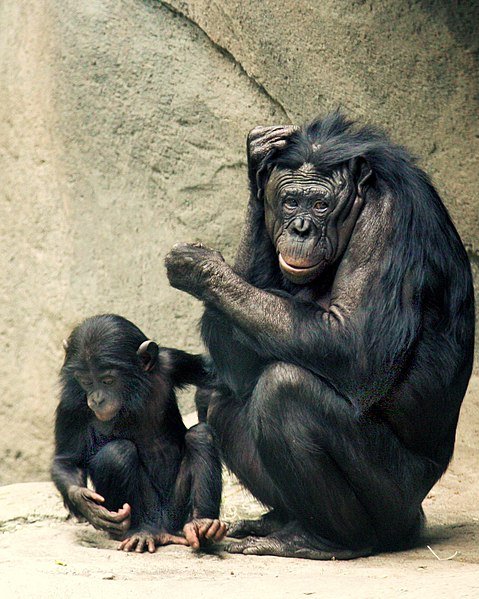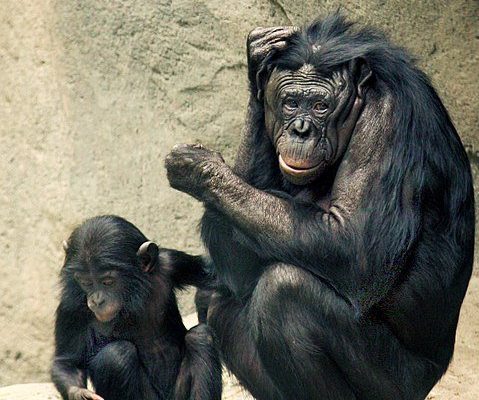
Bonobos are not just another type of ape; they hold a unique place in the great ape family tree. They’re often overshadowed by their more famous cousin, the chimpanzee, but bonobos have their own distinct traits and behaviors that make them equally intriguing. So, let’s dive into some common misconceptions about bonobos and explore the truth behind them.
Myth 1: Bonobos Are Just Like Chimpanzees
One of the biggest myths about bonobos is that they’re basically the same as chimpanzees. While they share a closer genetic relationship with each other than with any other primate, bonobos and chimpanzees have their differences. They diverged from a common ancestor around two million years ago, leading to distinct behaviors and social structures.
Bonobos are known for their more peaceful, matriarchal society. This means that female bonobos often lead the groups, while male chimps tend to dominate their social hierarchies. Bonobos also engage in a lot of social behaviors that we might call “playful” or “affectionate.” For example, they often use sexual interaction as a way to resolve conflicts and strengthen social bonds. It’s less about survival and more about cooperation.
You might be wondering why this matters. Understanding the difference helps us appreciate the diverse strategies primates have developed to live together. We can take a cue from bonobos on how connection and compassion can play a vital role in community living.
Myth 2: Bonobos Are ‘Hypersexual’ Creatures
Another common misconception is that bonobos are simply “hypersexual.” Yes, they engage in sexual behavior more frequently than many other species, but it’s crucial to understand the context. For bonobos, sexual activity serves various purposes beyond reproduction. Think of it like a social tool.
Bonobos use sexual behavior to maintain harmony within the group. When tensions arise, they may engage in sexual acts to diffuse the situation. This might sound strange at first, but it plays a significant role in conflict resolution among them. So, it’s not just about the act itself; it’s about fostering relationships and enhancing social bonds.
By labeling bonobos as hypersexual, we risk misinterpreting their social complexity. Instead of viewing them through a narrow lens, we should celebrate their unique approaches to intimacy and connection. Clearly, there’s a lot we could learn from their ways of navigating relationships.
Myth 3: Bonobos Are Less Intelligent Than Other Apes
You may have heard that bonobos are not as intelligent as their chimpanzee relatives. This myth couldn’t be further from the truth. In many ways, bonobos exhibit complex cognitive skills that rival or even exceed those of chimps. They demonstrate problem-solving abilities, tool use, and communication skills that show just how intelligent they truly are.
Studies have shown bonobos can understand symbols and can even communicate using sign language or visual symbols. In some cases, they might outperform chimps in specific tasks that require flexibility and creativity. This complexity in problem-solving is often overlooked, leading people to undervalue their intelligence.
So, when we talk about bonobos, it’s essential to recognize and appreciate their cognitive abilities. They’re not just playful and social; they have a depth of understanding and intelligence we should respect and learn about.
Myth 4: Bonobos Only Live in Captivity
Some folks might think that bonobos are creatures of captivity, like pandas at a zoo. In reality, while there are bonobos in various zoos and sanctuaries around the world, they naturally inhabit the rainforests of the Democratic Republic of Congo. These amazing apes thrive in their natural environment, where they can roam freely among the trees and develop their social structures.
However, bonobos face significant threats in the wild, including habitat loss and hunting. Conservation efforts are crucial to ensuring these animals can continue to live in their natural environments. Remember, wild bonobos are not just mere zoo exhibits—they’re essential parts of their ecosystems, and preserving their habitats is vital for biodiversity.
This myth emphasizes the importance of awareness about conservation. By understanding where bonobos live and the challenges they face, we can contribute to efforts to protect them and their environment.
Myth 5: Bonobos Have No Hierarchies
Many people believe that bonobos live in a completely egalitarian society without any hierarchies. While it’s true that their social structure differs from many other primates, saying they have no hierarchy at all is misleading. Bonobos do have social ranks, but these are often fluid and based on relationships rather than aggression.
In bonobo groups, females generally hold a higher status than males, which is quite different from the male-dominated structures seen in many other species. This matriarchy can create a more harmonious social environment overall. However, that doesn’t mean every bonobo is treated equally—dominance can exist, but it’s typically negotiated through social interactions rather than physical confrontations.
Understanding bonobo hierarchies helps us appreciate the nuances in their social interactions. It teaches us that while they value cooperation and community, there are still dynamics in play that influence relationships and behavior.
Myth 6: Bonobos Are Just ‘Peaceful Apes’
It’s easy to label bonobos as simply the “peaceful apes,” but this description misses the mark. Sure, they often resolve conflicts through playful behaviors and social bonding, but like all animals, they can display aggression. This myth oversimplifies their nature and can create a romanticized view of their lives.
Bonobos engage in aggressive behaviors, especially when it comes to defending their territory or resources. They are not exempt from the struggle for survival and must navigate complex social dynamics. Recognizing that bonobos can be both peaceful and aggressive allows for a more balanced understanding of their behavior.
This nuance is vital in appreciating the complexity of bonobo society. This mix of behaviors reflects the delicate balance of life in the wild, reminding us that even the most cooperative communities can face challenges.
Bonobos are fascinating creatures that challenge our understanding of primate behavior. From their social structures to their intelligence, there’s so much more than meets the eye. By debunking these common myths, we can gain a clearer picture of what bonobos are really like—not just as a species, but as intricate parts of our shared planet.
Understanding bonobos isn’t just about appreciating them as relatives; it teaches us valuable lessons about cooperation, compassion, and community. By fostering awareness and appreciation for these incredible primates, we can contribute to their conservation and ensure their continued existence in the wild. So, the next time you hear about bonobos, you’ll be equipped with the knowledge to share their true story, breaking down barriers of misconception along the way.

